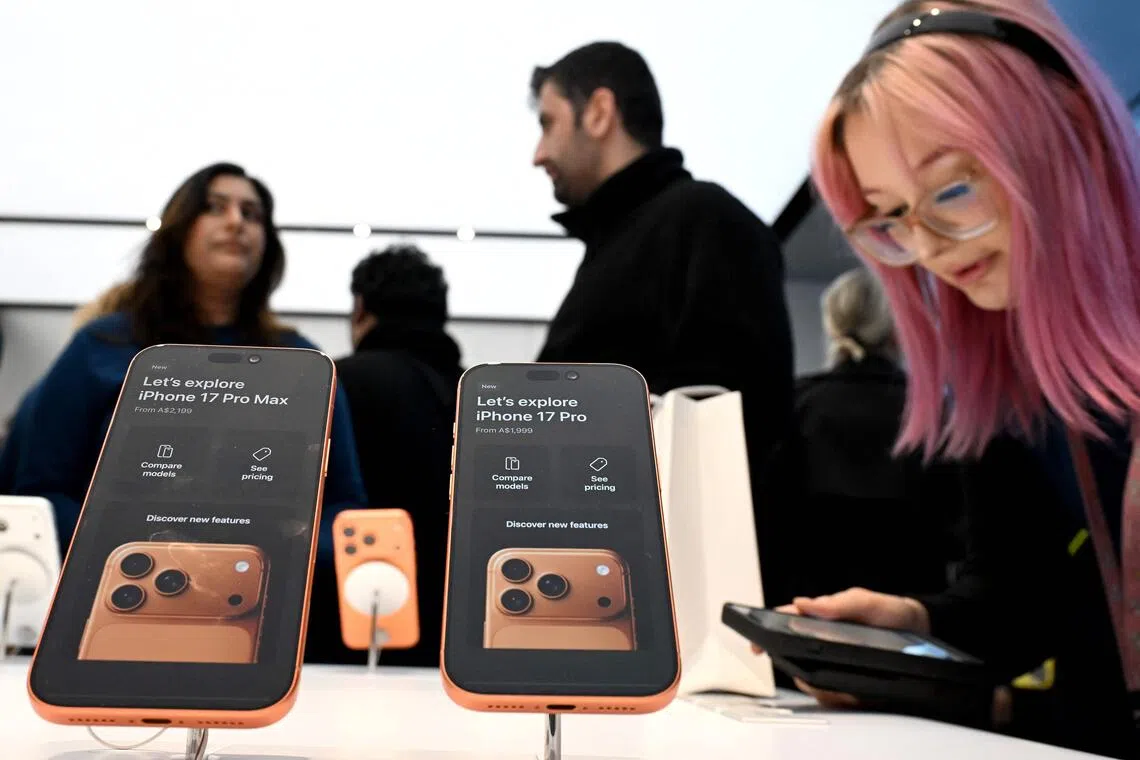Apple’s iPhone 17, Air go on sale to years of demand for new look
Sign up now: Get ST's newsletters delivered to your inbox

Customers explore the features of the newly launched iPhone 17 Pro at an Apple Store in Sydney, Australia, on Sept 19.
PHOTO: AFP
Follow topic:
For the past four years, some Apple customers have been waiting for a fresh design before buying a new iPhone.
The time has come for those consumers, with the iPhone 17 Pro, iPhone 17 Pro Max and iPhone Air going on sale on Sept 18.
In a first since 2020, Apple is rolling out several new iPhone designs.
The iPhone 17 Pro and 17 Pro Max move back to an aluminium shell and have a redesigned back, while the iPhone Air is Apple’s first crack at a new smartphone with its thin body as its main selling point.
Early data from pre-orders placed on Apple’s website, which are being delivered on Sept 19, suggest strong demand for the new Pro models.
The stakes are high for Apple.
The company is looking to meet expectations from Wall Street for its holiday period in the face of global economic concerns and the threat of future price increases due to tariffs.
Apple is also trying to convince consumers its mojo is back after its artificial intelligence strategy fell flat.
The new models’ reception in China will be of great importance to the company. Sales in the region fell 6 per cent from the year-earlier period, marking a steeper than usual slump ahead of a new release.
After years of success in the region last decade, Apple now holds only 12 per cent of the local market, trailing Oppo, Huawei Technologies, Xiaomi and others.
The launch of its latest major iteration of the iPhone – a product that debuted in 2007 – hits as Meta Platforms and others are moving on to AI-powered wearables, including smart glasses with displays.
The new models also land weeks after Alphabet’s Google and Samsung Electronics rolled out upgrades to their flagship smartphones.
Samsung, in particular, is a threat to the iPhone’s dominance. It launched a seventh-generation version of its foldable phone, which appears to be a hit with consumers due to its more durable frame and thinner look.
Apple will not have a foldable phone until the end of 2026, Bloomberg News has reported.
The iPhone 17 Pro line is likely to be the one that resonates most with buyers because it improves the features that people most want in a new phone: battery life, camera technology and durability. It’s also priced from US$1,099 (S$1,410), only US$100 more than the iPhone 16 Pro it replaces.
“Prices are being really increased for the first time in several years, so if we see a typical replacement cycle with higher prices, plus some progress on AI, that may not be an exciting set-up for the stock, but it’s a decent one,” said Mr John Belton, portfolio manager at Gabelli Funds, which has US$33 billion in assets under management.
The iPhone Air, on the other hand, may not drive sales despite the attention it will receive.
The US$999 device focuses on a thin profile, but has drawbacks in battery life and cameras. It also costs as much as a 17 Pro after factoring an optional magnetic battery attachment to increase battery life.
Earlier in 2025, Samsung launched the S25 Edge, using a similar concept to Apple’s Air. Thus far, it has been a sales dud. BLOOMBERG

